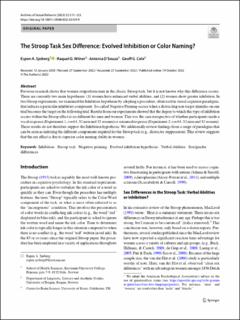| dc.contributor.author | Sjøberg, Espen A. | |
| dc.contributor.author | Wilner, Raquel Gloria | |
| dc.contributor.author | D'Souza, Antonia | |
| dc.contributor.author | Cole, Geof G. | |
| dc.date.accessioned | 2023-02-23T10:35:02Z | |
| dc.date.available | 2023-02-23T10:35:02Z | |
| dc.date.created | 2022-10-23T12:39:19Z | |
| dc.date.issued | 2023 | |
| dc.identifier.citation | Archives of Sexual Behavior. 2023, 52, 315–323 | en_US |
| dc.identifier.issn | 0004-0002 | |
| dc.identifier.uri | https://hdl.handle.net/11250/3053561 | |
| dc.description.abstract | Previous research shows that women outperform men in the classic Stroop task, but it is not known why this difference occurs. There are currently two main hypotheses: (1) women have enhanced verbal abilities, and (2) women show greater inhibition. In two Stroop experiments, we examined the Inhibition hypothesis by adopting a procedure, often used in visual cognition paradigms, that induces a particular inhibitory component. So-called Negative Priming occurs when a distracting non-target stimulus on one trial becomes the target on the following trial. Results from our experiments showed that the degree to which this type of inhibition occurs within the Stroop effect is no different for men and women. This was the case irrespective of whether participants made a vocal response (Experiment 1; n = 64, 32 men and 32 women) or a manual response (Experiment 2; n = 64, 32 men and 32 women). These results do not therefore support the Inhibition hypothesis. We additionally review findings from a range of paradigms that can be seen as indexing the different components required for the Stroop task (e.g., distractor suppression). This review suggests that the sex effect is due to superior color naming ability in women. | en_US |
| dc.language.iso | eng | en_US |
| dc.rights | Navngivelse 4.0 Internasjonal | * |
| dc.rights.uri | http://creativecommons.org/licenses/by/4.0/deed.no | * |
| dc.subject | inhibition | en_US |
| dc.subject | stroop task | en_US |
| dc.subject | negative priming | en_US |
| dc.subject | evolved inhibition hypothesis | en_US |
| dc.subject | verbal abilities | en_US |
| dc.subject | sex differences | en_US |
| dc.subject | gender differences | en_US |
| dc.subject | kjønnsforskjeller | en_US |
| dc.subject | negativ priming | en_US |
| dc.subject | verbale evner | en_US |
| dc.subject | inhibisjon | en_US |
| dc.title | The stroop task sex difference: Evolved inhibition or color naming? | en_US |
| dc.type | Peer reviewed | en_US |
| dc.type | Journal article | en_US |
| dc.description.version | publishedVersion | en_US |
| dc.source.pagenumber | 1-9 | en_US |
| dc.source.volume | 52 | en_US |
| dc.source.journal | Archives of Sexual Behavior | en_US |
| dc.source.issue | 315–323 | en_US |
| dc.identifier.doi | 10.1007/s10508-022-02439-9 | |
| dc.identifier.cristin | 2064046 | |
| cristin.ispublished | true | |
| cristin.fulltext | original | |
| cristin.qualitycode | 1 | |

